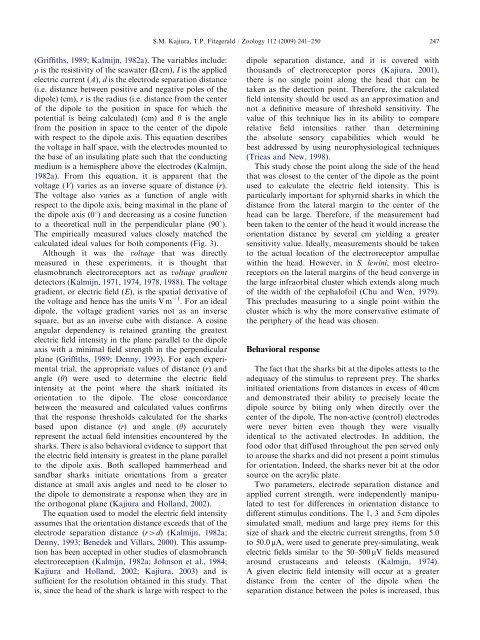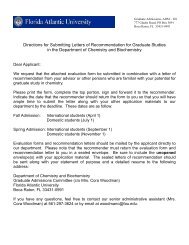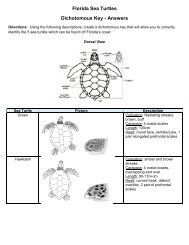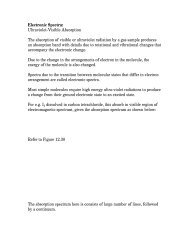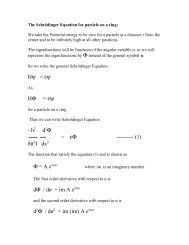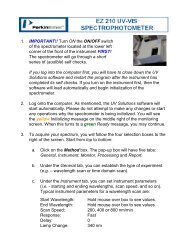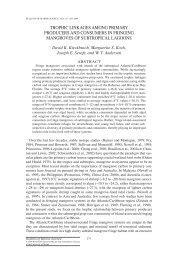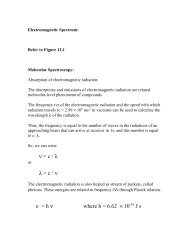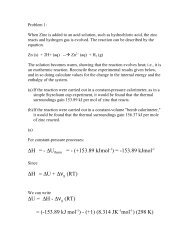Response of juvenile scalloped hammerhead sharks to electric stimuli
Response of juvenile scalloped hammerhead sharks to electric stimuli
Response of juvenile scalloped hammerhead sharks to electric stimuli
- No tags were found...
Create successful ePaper yourself
Turn your PDF publications into a flip-book with our unique Google optimized e-Paper software.
ARTICLE IN PRESSS.M. Kajiura, T.P. Fitzgerald / Zoology 112 (2009) 241–250 247(Griffiths, 1989; Kalmijn, 1982a). The variables include:r is the resistivity <strong>of</strong> the seawater (O cm), I is the applied<strong>electric</strong> current (A), d is the electrode separation distance(i.e. distance between positive and negative poles <strong>of</strong> thedipole) (cm), r is the radius (i.e. distance from the center<strong>of</strong> the dipole <strong>to</strong> the position in space for which thepotential is being calculated) (cm) and y is the anglefrom the position in space <strong>to</strong> the center <strong>of</strong> the dipolewith respect <strong>to</strong> the dipole axis. This equation describesthe voltage in half space, with the electrodes mounted <strong>to</strong>the base <strong>of</strong> an insulating plate such that the conductingmedium is a hemisphere above the electrodes (Kalmijn,1982a). From this equation, it is apparent that thevoltage (V) varies as an inverse square <strong>of</strong> distance (r).The voltage also varies as a function <strong>of</strong> angle withrespect <strong>to</strong> the dipole axis, being maximal in the plane <strong>of</strong>the dipole axis (01) and decreasing as a cosine function<strong>to</strong> a theoretical null in the perpendicular plane (901).The empirically measured values closely matched thecalculated ideal values for both components (Fig. 3).Although it was the voltage that was directlymeasured in these experiments, it is thought thatelasmobranch electrorecep<strong>to</strong>rs act as voltage gradientdetec<strong>to</strong>rs (Kalmijn, 1971, 1974, 1978, 1988). The voltagegradient, or <strong>electric</strong> field (E), is the spatial derivative <strong>of</strong>the voltage and hence has the units V m 1 . For an idealdipole, the voltage gradient varies not as an inversesquare, but as an inverse cube with distance. A cosineangular dependency is retained granting the greatest<strong>electric</strong> field intensity in the plane parallel <strong>to</strong> the dipoleaxis with a minimal field strength in the perpendicularplane (Griffiths, 1989; Denny, 1993). For each experimentaltrial, the appropriate values <strong>of</strong> distance (r) andangle (y) were used <strong>to</strong> determine the <strong>electric</strong> fieldintensity at the point where the shark initiated itsorientation <strong>to</strong> the dipole. The close concordancebetween the measured and calculated values confirmsthat the response thresholds calculated for the <strong>sharks</strong>based upon distance (r) and angle (y) accuratelyrepresent the actual field intensities encountered by the<strong>sharks</strong>. There is also behavioral evidence <strong>to</strong> support thatthe <strong>electric</strong> field intensity is greatest in the plane parallel<strong>to</strong> the dipole axis. Both <strong>scalloped</strong> <strong>hammerhead</strong> andsandbar <strong>sharks</strong> initiate orientations from a greaterdistance at small axis angles and need <strong>to</strong> be closer <strong>to</strong>the dipole <strong>to</strong> demonstrate a response when they are inthe orthogonal plane (Kajiura and Holland, 2002).The equation used <strong>to</strong> model the <strong>electric</strong> field intensityassumes that the orientation distance exceeds that <strong>of</strong> theelectrode separation distance (r4d) (Kalmijn, 1982a;Denny, 1993; Benedek and Villars, 2000). This assumptionhas been accepted in other studies <strong>of</strong> elasmobranchelectroreception (Kalmijn, 1982a; Johnson et al., 1984;Kajiura and Holland, 2002; Kajiura, 2003) and issufficient for the resolution obtained in this study. Thatis, since the head <strong>of</strong> the shark is large with respect <strong>to</strong> thedipole separation distance, and it is covered withthousands <strong>of</strong> electrorecep<strong>to</strong>r pores (Kajiura, 2001),there is no single point along the head that can betaken as the detection point. Therefore, the calculatedfield intensity should be used as an approximation andnot a definitive measure <strong>of</strong> threshold sensitivity. Thevalue <strong>of</strong> this technique lies in its ability <strong>to</strong> comparerelative field intensities rather than determiningthe absolute sensory capabilities which would bebest addressed by using neurophysiological techniques(Tricas and New, 1998).This study chose the point along the side <strong>of</strong> the headthat was closest <strong>to</strong> the center <strong>of</strong> the dipole as the pointused <strong>to</strong> calculate the <strong>electric</strong> field intensity. This isparticularly important for sphyrnid <strong>sharks</strong> in which thedistance from the lateral margin <strong>to</strong> the center <strong>of</strong> thehead can be large. Therefore, if the measurement hadbeen taken <strong>to</strong> the center <strong>of</strong> the head it would increase theorientation distance by several cm yielding a greatersensitivity value. Ideally, measurements should be taken<strong>to</strong> the actual location <strong>of</strong> the electrorecep<strong>to</strong>r ampullaewithin the head. However, in S. lewini, most electrorecep<strong>to</strong>rson the lateral margins <strong>of</strong> the head converge inthe large infraorbital cluster which extends along much<strong>of</strong> the width <strong>of</strong> the cephal<strong>of</strong>oil (Chu and Wen, 1979).This precludes measuring <strong>to</strong> a single point within thecluster which is why the more conservative estimate <strong>of</strong>the periphery <strong>of</strong> the head was chosen.Behavioral responseThe fact that the <strong>sharks</strong> bit at the dipoles attests <strong>to</strong> theadequacy <strong>of</strong> the stimulus <strong>to</strong> represent prey. The <strong>sharks</strong>initiated orientations from distances in excess <strong>of</strong> 40 cmand demonstrated their ability <strong>to</strong> precisely locate thedipole source by biting only when directly over thecenter <strong>of</strong> the dipole. The non-active (control) electrodeswere never bitten even though they were visuallyidentical <strong>to</strong> the activated electrodes. In addition, thefood odor that diffused throughout the pen served only<strong>to</strong> arouse the <strong>sharks</strong> and did not present a point stimulusfor orientation. Indeed, the <strong>sharks</strong> never bit at the odorsource on the acrylic plate.Two parameters, electrode separation distance andapplied current strength, were independently manipulated<strong>to</strong> test for differences in orientation distance <strong>to</strong>different stimulus conditions. The 1, 3 and 5 cm dipolessimulated small, medium and large prey items for thissize <strong>of</strong> shark and the <strong>electric</strong> current strengths, from 5.0<strong>to</strong> 50.0 mA, were used <strong>to</strong> generate prey-simulating, weak<strong>electric</strong> fields similar <strong>to</strong> the 50–500 mV fields measuredaround crustaceans and teleosts (Kalmijn, 1974).A given <strong>electric</strong> field intensity will occur at a greaterdistance from the center <strong>of</strong> the dipole when theseparation distance between the poles is increased, thus


